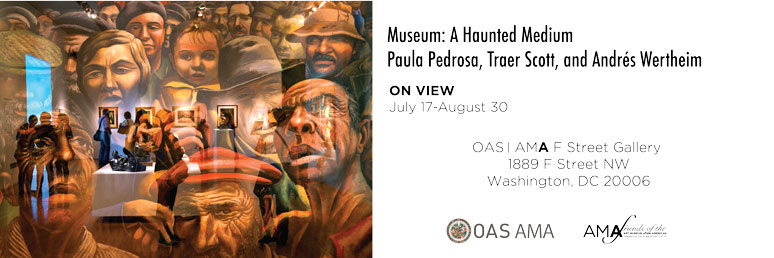ORGANIZATION OF AMERICAN STATES
AMA | ART MUSEUM OF THE AMERICAS
Secretariat for Hemispheric Affairs
Museum: A Haunted Medium
Paula Pedrosa, Traer Scott, and Andrés Wertheim
ON VIEW
July 17-August 30
LOCATION
AMA F Street Gallery
OAS General Secretariat Building
1889 F Street NW
Washington, DC 20006
HOURS
By appointment only
Please call 202 370 0151
OPENING RECEPTION
Wednesday, July 17
6-8PM
RSVP here
ADMISSION
Free
The OAS AMA | Art Museum of the Americas presents Museum: A Haunted Medium, an exhibition of work by photographers Paula Pedrosa (Brazil), Traer Scott (United States), and Andrés Wertheim (Argentina). In these works, natural history and art museums, gallery spaces, and theme parks all become mediums, encouraging interactions. Grand expectations are resolved by the magic of communication that occurs in the dialog between the viewer and the viewed. Scott captures the interaction between the ghostlike human reflection on the glass and the frozen motion of animals as part of ornate wildlife landscapes. Pedrosa depicts staged, cripplingly decorated interior jungle-like and rainforest landscapes painted onto interior surfaces, fantasies creating expectations of life as it may be. Wertheim forges fusions between the audiences in the museum and the portrayed characters in the same spaces’ galleries. Interactions throughout, between the living and the dead, the past and the present, and natural and the artificial, contextualized amid the fleetingness of existence, reveals that it is perhaps we who are more truly ghosts in the museum.
These three artists: Paula Pedrosa, Brazil, Traer Scott, U.S., and Andrés Wertheim, Argentina, wander into museums looking to capture the visitor’s interaction with museum pieces and dioramas, creating a new piece where this interaction manifests itself in a haunted image. Natural history and art museums, gallery spaces, and theme parks are all mediums which encourage interactions that, in turn, create expectations. These grand expectations are resolved by the magic of communication that occurs in the dialogue between the viewer and the viewed.
Medium is described by the dictionary as simply a middle state; something that is intermediate between two qualities or degrees. It can also mean a person or an object that acts as an intermediary; channel or conduit of communication. As Traer Scott says, “every image is like solving a mystery that I didn’t know existed.” Scott captures the interaction between the human ghostlike reflection on the glass and the frozen motion of animals in action as part of ornate wildlife landscapes of the natural history dioramas.
In Paula Pedrosa’s images, interactions between the natural and artificial as seen in dioramas of wildlife are captured. These scenes depict staged and cripplingly decorated interior jungle-like and rain-forest landscapes painted on walls, glass, windows, and doors. These fantasies are reinforced by fake rock formations and props, creating expectations based on the fantasy of the recreation of life as it was.
Similarly, Andres Wertheim integrates these concepts into his work: “I merge in one photoframe both planes of the visible reality - the audience in a museum’s room and the portrayed characters on the same room’s walls -trying to create a dialogue between them. When the fusion works, I feel that the “spirits” of the museum have finally allowed me to see them.”
Through this exhibition interactions between the living and the dead, the past and the present, and the natural and the artificial create a shared dialogue about the function of museums and displays in the human experience as it relates to the past and our environment. As Professor and curator Alasdair Foster puts it, “It is our mortality that measures time, not theirs. They haunt us not because they are dead, but because they endure while we do not. We are the imaginative means by which they converse in this latter-day agora. But, in the fleetingness of our existence, it is perhaps we who are more truly ghosts in the museum.”
The AMA serves as the principal instrument of cultural diplomacy of the OAS. AMA’s mission is founded on the notion that the arts are transformative for individuals and communities. This guiding principle promotes the core values of the OAS by providing a space for cultural expression, creativity, innovation, dialog, and learning, while highlighting themes such as democracy, development, human rights, justice, freedom of expression, and innovation. AMA’s work draws on contemporary art to showcase a constructive vision of the future of the Americas via local and hemispheric cultural exchange.
Accessibility: The OAS AMA F Street Gallery is wheelchair accessible. For more information, please call 202 370 0147 or email gsvitil@oas.org.
.


